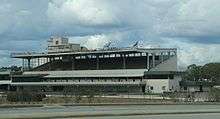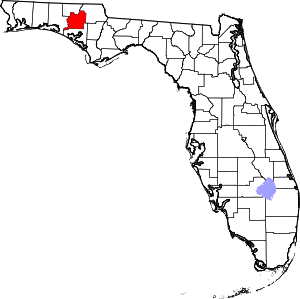Ebro, Florida
Ebro is a town in Washington County, Florida, United States. The population was 270 at the 2010 census. As of 2018, the population recorded by the U.S. Census Bureau is 275.
Ebro, Florida | |
|---|---|
 Looking northerly at the intersection of State Routes 20 and 79 in Ebro | |
 Location in Washington County and the state of Florida | |
| Coordinates: 30°26′35″N 85°52′51″W | |
| Country | |
| State | |
| County | Washington |
| Area | |
| • Total | 4.83 sq mi (12.51 km2) |
| • Land | 4.72 sq mi (12.24 km2) |
| • Water | 0.10 sq mi (0.27 km2) |
| Elevation | 75 ft (23 m) |
| Population (2010) | |
| • Total | 270 |
| • Estimate (2019)[2] | 280 |
| • Density | 59.26/sq mi (22.88/km2) |
| Time zone | UTC-6 (Central (CST)) |
| • Summer (DST) | UTC-5 (CDT) |
| ZIP code | 32437 |
| Area code(s) | 850 |
| FIPS code | 12-19725[3] |
| GNIS feature ID | 0282067[4] |
It is believed the Spanish named the town, as there is an Ebro River in Spain.
Geography
Ebro is located in the southwestern part of Washington County at 30°26′35″N 85°52′51″W (30.443152, -85.880790).[5] It is the closest municipality to Northwest Florida Beaches International Airport.
Florida State Roads 20 and 79 are the main roads through the town. FL-79 runs from north to south to the east of the town, leading north 31 mi (50 km) to Bonifay along Interstate 10 and south 16 mi (26 km) to U.S. Route 98 near Panama City Beach. FL-20 runs from west to east through the center of town, leading east 51 mi (82 km) to Blountstown and west 17 mi (27 km) to Freeport.
According to the United States Census Bureau, the town has a total area of 3.2 square miles (8.3 km2). 3.2 square miles (8.3 km2) of it is land and 0.1 square miles (0.26 km2) of it (1.56%) is water.
Demographics
| Historical population | |||
|---|---|---|---|
| Census | Pop. | %± | |
| 1970 | 125 | — | |
| 1980 | 233 | 86.4% | |
| 1990 | 255 | 9.4% | |
| 2000 | 250 | −2.0% | |
| 2010 | 270 | 8.0% | |
| Est. 2019 | 280 | [2] | 3.7% |
| U.S. Decennial Census[6] | |||
As of the census[3] of 2000, there were 250 people, 102 households, and 63 families residing in the town. The population density was 79.4 inhabitants per square mile (30.6/km2). There were 116 housing units at an average density of 36.8 per square mile (14.2/km2). The racial makeup of the town was 73.60% White, 3.60% African American, 6.40% Native American, 0.40% Pacific Islander, 0.40% from other races, and 15.60% from two or more races. Hispanic or Latino of any race were 4.40% of the population.
There were 102 households, out of which 33.3% had children under the age of 18 living with them, 47.1% were married couples living together, 10.8% had a female householder with no husband present, and 38.2% were non-families. 32.4% of all households were made up of individuals, and 9.8% had someone living alone who was 65 years of age or older. The average household size was 2.45 and the average family size was 3.10.
In the town, the population was spread out, with 23.2% under the age of 18, 12.0% from 18 to 24, 29.2% from 25 to 44, 27.6% from 45 to 64, and 8.0% who were 65 years of age or older. The median age was 36 years. For every 100 females, there were 98.4 males. For every 100 females age 18 and over, there were 102.1 males.
The median income for a household in the town was $28,750, and the median income for a family was $40,833. Males had a median income of $33,333 versus $25,208 for females. The per capita income for the town was $14,504. About 20.6% of families and 21.0% of the population were below the poverty line, including 22.6% of those under the age of eighteen and 25.0% of those 65 or over.
Images
 Sign for Ebro on State Route 79
Sign for Ebro on State Route 79 Ebro Greyhound Park
Ebro Greyhound Park
References
| Wikimedia Commons has media related to Ebro, Florida. |
- "2019 U.S. Gazetteer Files". United States Census Bureau. Retrieved July 2, 2020.
- "Population and Housing Unit Estimates". United States Census Bureau. May 24, 2020. Retrieved May 27, 2020.
- "U.S. Census website". United States Census Bureau. Retrieved 2008-01-31.
- "US Board on Geographic Names". United States Geological Survey. 2007-10-25. Retrieved 2008-01-31.
- "US Gazetteer files: 2010, 2000, and 1990". United States Census Bureau. 2011-02-12. Retrieved 2011-04-23.
- "Census of Population and Housing". Census.gov. Retrieved June 4, 2015.
